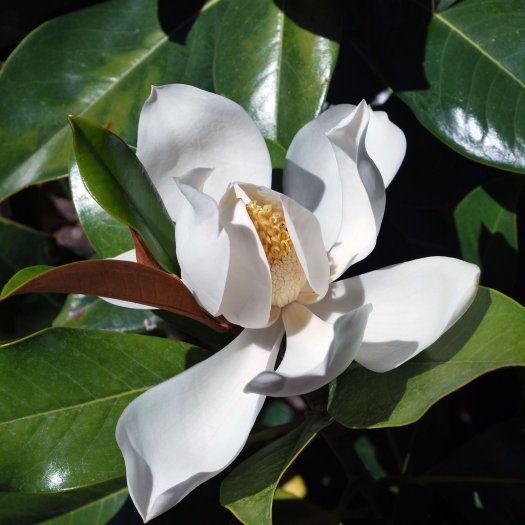Magnolia grandiflora
Nomes
|
Pt.: Magnólia-de-flores-grandes, magnólia, magnólia-sempre-verde |
| Eng.: | |
|
Magnolia grandiflora |
|
|
|
Epíteto específico: latinização proveniente das palavras latinas grandis (grande) + flor-, flos (flor) |
|
Descrição
|
|
|
|
|
|
|
|
|
|
|
|
Variedades
|
|
|
|
|
"Over 50 cultivars have been developed and named in North America and Europe. Most plants in nurseries are propagated by cuttings, resulting in more consistent form in the various varieties available.[18] Many older cultivars have been superseded by newer ones and are no longer available. Some cultivars have been found to be more cold hardy, they include: |
| 'Bracken's Brown Beauty' | developed by Ray Bracken of Easley, South Carolina, in the late 1960s, is a popular cultivar which has survived long-term in southern Ohio, West Virginia, New Jersey, and Long Island, NY. This cultivar grows in a dense and compact pattern, with narrow, medium-sized, glossy leaves. Flowers measure 5–6 in (13–15 cm). |
| 'Edith Bogue' | was brought to the coastal plain of New Jersey from Florida in the 1920s. The original tree sent to Edith A. Bogue from Florida helped to establish cold-hardy specimens in the Middle Atlantic states from Delaware to coastal Connecticut. Once established, 'Edith Bogue' has been known to have only minor spotting and margin burn on the leaf in temperatures as low as −5 °F (−21 °C). With a vigorous classic pyramidal shape, this cultivar grows to 35 ft with a 15-ft spread. |
| 'Angustifolia' | developed in France in 1825, has narrow, spear-shaped leaves 20 cm (7.9 in) long by 11 cm (4.3 in) wide, as its name suggests. |
| 'Exmouth' | was developed in the early 18th century by John Colliton in Devon. It is notable for its huge flowers, with up to 20 tepals, and vigorous growth. Erect in habit, it is often planted against walls. The leaves are green above and brownish underneath. The flowers are very fragrant and the leaves are narrow and leathery. |
| 'Goliath' | was developed by Caledonia Nurseries of Guernsey, and has a bushier habit and globular flowers of up to 30 cm (12 in) diameter. Long-flowering, it has oval leaves which lack the brownish hair underneath. |
| 'Little Gem' | a dwarf cultivar, is grown in more moderate climates, roughly from Maryland and the Virginias southward. Originally developed in 1952 by Steed's Nursery in Candor, North Carolina, it is a slower-growing form with a columnar shape which reaches around 4.25 m (13.9 ft) high and 1.2 m (3.9 ft) wide. Flowering heavily over an extended period in warmer climate, it bears medium-sized, cup-shaped flowers, and has elliptic leaves 12.5 cm (4.9 in) long by 5 cm (2.0 in) wide. |
| Other commonly grown cultivars include: | |
| 'Ferruginea' | has dark-green leaves with rust-brown undersides. |
| 'Southern Charm' | has large oval leaves, bushy habit, and smaller growth. It is also known as 'Teddy Bear' |
| Da Wikipédia (2016-10-26) | |
|

